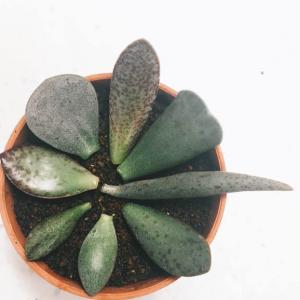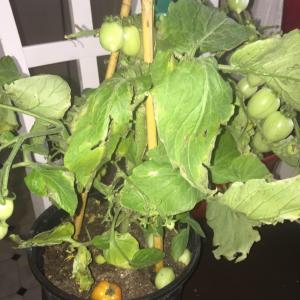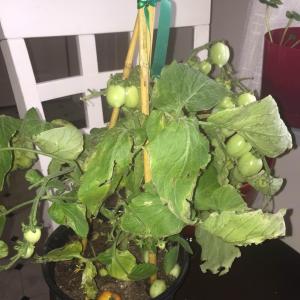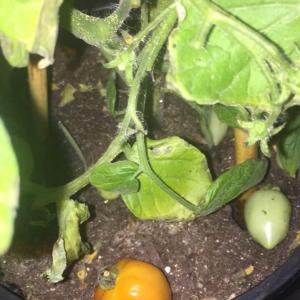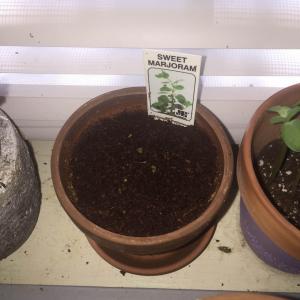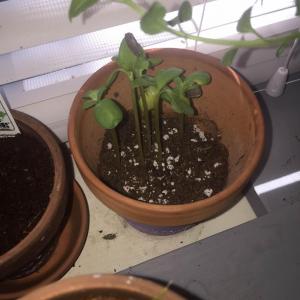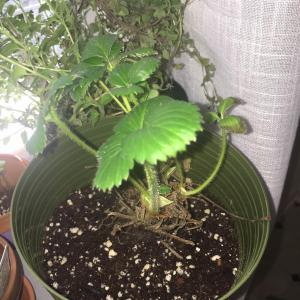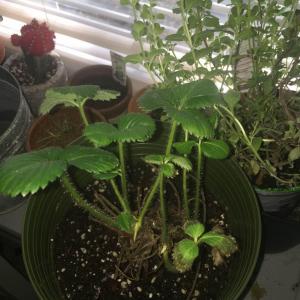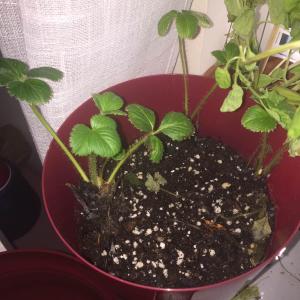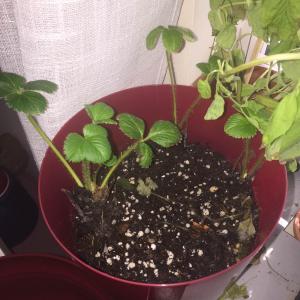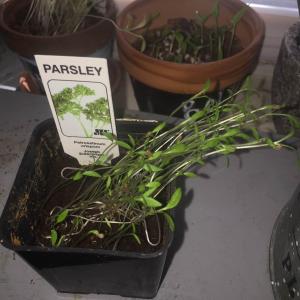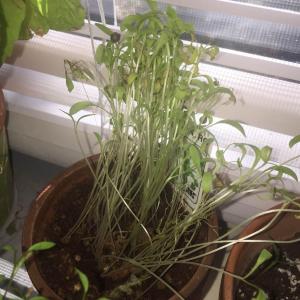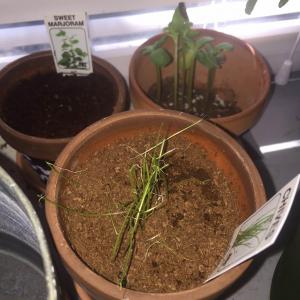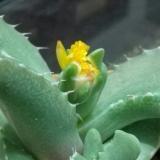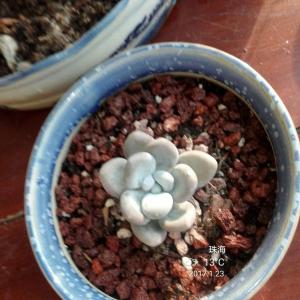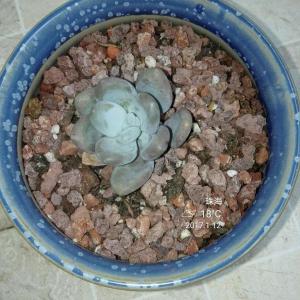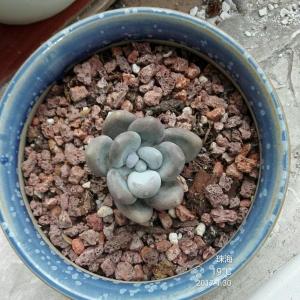文章
Miss Chen
2018年02月09日

Description: This perennial herbaceous plant is 1-3' tall, branching frequently to create a bushy effect. The slender stems are hairless. The slender opposite leaves are up to 3" long and ¼" across. Each leaf is sessile, linear, and hairless, with a prominent central vein and smooth margins.

The upper stems terminate in small flat heads of flowers. The short tubular flowers are white, often with scattered purple dots, and individually about ¼" long. The corolla is divided into an upper lip and a lower lip with three lobes. The reproductive structures of each flower are white, except that the anthers are purple. The calyx is divided into several slender green lobes. The blooming period is early to mid-summer, and lasts about 1–1½ months. There is no floral scent, although the foliage has a mild mint scent and somewhat stronger minty taste. The small dark seeds are without tufts of hairs, but are small enough to be dispersed by gusts of wind. The root system consists of a taproot and rhizomes. Slender Mountain Mint can spread vegetatively, forming colonies of closely bunched plants.
Cultivation: The preference is full sun and moist to slightly dry conditions. This plant often grows in rich loam, as well as soil containing rocky or gravelly material. Foliar disease is less troublesome for this mint species than many others. The leaves may assume a yellowish appearance during a major drought. This is an easy plant to grow.

Range & Habitat: The native Slender Mountain Mint occurs occasionally in every county of southern and central Illinois, but is less common and more sporadic in northern Illinois (see Distribution Map). Habitats include moist to slightly dry black soil prairies, moist meadows and gravelly areas along rivers, openings in woodlands, moist thickets, acid gravel seeps, limestone glades, and abandoned fields.
Faunal Associations: The flowers are very attractive to many kinds of insects, including long-tongued bees, short-tongued bees, wasps, flies, butterflies, skippers, beetles, and plant bugs. These insects usually seek nectar. Among the wasps, are such visitors as Thread-Waisted wasps, Bee Wolves (Philanthus spp.), Scoliid wasps, Tiphiid wasps, Sand wasps, Spider wasps, and Eumenine wasps. Flies visitors include Soldier flies, Syrphid flies, Mydas flies, bee flies, Thick-Headed flies, and Tachinid flies. The seeds are too small to be of much interest to birds. Mammalian herbivores usually don't browse on this plant because of the minty taste; the foliage may contain anti-bacterial substances that disrupt the digestive process of herbivores.
Photographic Location: The photographs were taken at Meadowbrook Park in Urbana, Illinois.
Comments: This plant has a delicate, somewhat airy appearance. Slender Mountain Mint closely resembles Pycnanthemum virginianum (Common Mountain Mint), except that the former has hairless stems and leaves that never exceed ¼" across. Common Mountain Mint, on the other hand, has lines of white hairs on its stems, and some of the larger leaves will exceed ¼" across. This latter plant tends to be taller, stouter, and less branched in appearance; it also blooms a little later in the year. The photographed flowering plant is still in the bud stage, while the photographed flowerheads are beginning to bloom.

The upper stems terminate in small flat heads of flowers. The short tubular flowers are white, often with scattered purple dots, and individually about ¼" long. The corolla is divided into an upper lip and a lower lip with three lobes. The reproductive structures of each flower are white, except that the anthers are purple. The calyx is divided into several slender green lobes. The blooming period is early to mid-summer, and lasts about 1–1½ months. There is no floral scent, although the foliage has a mild mint scent and somewhat stronger minty taste. The small dark seeds are without tufts of hairs, but are small enough to be dispersed by gusts of wind. The root system consists of a taproot and rhizomes. Slender Mountain Mint can spread vegetatively, forming colonies of closely bunched plants.
Cultivation: The preference is full sun and moist to slightly dry conditions. This plant often grows in rich loam, as well as soil containing rocky or gravelly material. Foliar disease is less troublesome for this mint species than many others. The leaves may assume a yellowish appearance during a major drought. This is an easy plant to grow.

Range & Habitat: The native Slender Mountain Mint occurs occasionally in every county of southern and central Illinois, but is less common and more sporadic in northern Illinois (see Distribution Map). Habitats include moist to slightly dry black soil prairies, moist meadows and gravelly areas along rivers, openings in woodlands, moist thickets, acid gravel seeps, limestone glades, and abandoned fields.
Faunal Associations: The flowers are very attractive to many kinds of insects, including long-tongued bees, short-tongued bees, wasps, flies, butterflies, skippers, beetles, and plant bugs. These insects usually seek nectar. Among the wasps, are such visitors as Thread-Waisted wasps, Bee Wolves (Philanthus spp.), Scoliid wasps, Tiphiid wasps, Sand wasps, Spider wasps, and Eumenine wasps. Flies visitors include Soldier flies, Syrphid flies, Mydas flies, bee flies, Thick-Headed flies, and Tachinid flies. The seeds are too small to be of much interest to birds. Mammalian herbivores usually don't browse on this plant because of the minty taste; the foliage may contain anti-bacterial substances that disrupt the digestive process of herbivores.
Photographic Location: The photographs were taken at Meadowbrook Park in Urbana, Illinois.
Comments: This plant has a delicate, somewhat airy appearance. Slender Mountain Mint closely resembles Pycnanthemum virginianum (Common Mountain Mint), except that the former has hairless stems and leaves that never exceed ¼" across. Common Mountain Mint, on the other hand, has lines of white hairs on its stems, and some of the larger leaves will exceed ¼" across. This latter plant tends to be taller, stouter, and less branched in appearance; it also blooms a little later in the year. The photographed flowering plant is still in the bud stage, while the photographed flowerheads are beginning to bloom.
0
0
文章
Miss Chen
2018年02月08日

Description: This perennial plant sprawls along the ground by means of stolons; it is less than 1' tall. The slender stems and stolons are initially green, but become red with age. Depending on the local ecotype, they can be nearly glabrous, or covered with spreading white hairs. The stolons can extend up to 3' and their tips often root in the ground, forming new plantlets. The compound leaves are palmate (with 5 leaflets) and alternate along the stolons or stems. Each leaflet is up to 3" long and ¾" across. There is coarse serration along the margins, except near the base, and prominent venation. The upper surface is glabrous, while the lower surface may be hairy or nearly glabrous. The leaflets are narrowly ovate (but with blunt tips), obovate, or oblanceolate; young leaflets often have their margins curled upward. A single yellow flower develops from a long pedicel from the upper axils of some of the compound leaves. This flower is about ½" across, and has 5 yellow petals that are narrow at the base, but rounded toward their tips, which are sometimes notched. The green calyx has 5 triangular tips that are a little shorter than the petals. The center of the flower has a somewhat flattened reproductive structure, which is surrounded by about 20 stamens. The blooming period can occur from spring to mid-summer, and lasts about a month. Only a few flowers are in bloom at the same time. There is no noticeable floral scent. The achenes are without tufts of hair. There is a short, thick rootstock that divides into coarse secondary roots. This plant often forms loose colonies by means of its stolons.

Cultivation: The preference is partial to full sun, and moist to dry conditions. The soil can consist of loam, clay-loam, or contain gravelly material. This is an easy plant to grow that presents few problems.
Range & Habitat: The native Common Cinquefoil occurs in every county of Illinois and it is fairly common (see Distribution Map). Habitats include mesic to dry black soil prairies, open upland forests, savannas, gravelly seeps, and abandoned fields. This plant occurs in both disturbed areas and high quality habitats. In tallgrass prairies, it is one of the understory plants.
Faunal Associations: The flowers primarily attract small bees and flies, including Mason bees, Small Carpenter bees, Nomadine Cuckoo bees, Halictid bees, Syrphid flies, Tachinid flies, Blow flies, and others. Less common visitors are wasps, skippers, and butterflies. These insects seek nectar, although bees also collect pollen. The seeds are little used by birds. Small mammalian herbivores, such as rabbits and groundhogs, often eat the foliage. It is possible that some of the seeds of Common Cinquefoil can pass through their digestive tracts unharmed, and are thus distributed by them; some studies involving livestock have found this to be the case with a similar species, Potentilla recta (Sulfur Cinquefoil).
Photographic Location: The above photographs were taken at Loda Cemetery Prairie in Iroquois County, Illinois.
Comments: This is another plant that fits the stereotype of a weed, but it also occurs in prairies and other native habitats. The flowers are reasonably showy during the spring, but few in number. Common Cinquefoil resembles many other species of Cinquefoil, both native and introduced. Its compound leaves almost always have 5 leaflets, the flowers are bright yellow, and it sprawls along the ground; other species often have a fewer or greater number of leaflets, their flowers may be white or pale yellow, or they are erect. Common Cinquefoil is perhaps most similar to the native Potentilla canadensis (Dwarf Cinquefoil), except that the latter is a smaller plant with blunter leaftlets that are strongly obovate or oblanceolate.

Cultivation: The preference is partial to full sun, and moist to dry conditions. The soil can consist of loam, clay-loam, or contain gravelly material. This is an easy plant to grow that presents few problems.
Range & Habitat: The native Common Cinquefoil occurs in every county of Illinois and it is fairly common (see Distribution Map). Habitats include mesic to dry black soil prairies, open upland forests, savannas, gravelly seeps, and abandoned fields. This plant occurs in both disturbed areas and high quality habitats. In tallgrass prairies, it is one of the understory plants.
Faunal Associations: The flowers primarily attract small bees and flies, including Mason bees, Small Carpenter bees, Nomadine Cuckoo bees, Halictid bees, Syrphid flies, Tachinid flies, Blow flies, and others. Less common visitors are wasps, skippers, and butterflies. These insects seek nectar, although bees also collect pollen. The seeds are little used by birds. Small mammalian herbivores, such as rabbits and groundhogs, often eat the foliage. It is possible that some of the seeds of Common Cinquefoil can pass through their digestive tracts unharmed, and are thus distributed by them; some studies involving livestock have found this to be the case with a similar species, Potentilla recta (Sulfur Cinquefoil).
Photographic Location: The above photographs were taken at Loda Cemetery Prairie in Iroquois County, Illinois.
Comments: This is another plant that fits the stereotype of a weed, but it also occurs in prairies and other native habitats. The flowers are reasonably showy during the spring, but few in number. Common Cinquefoil resembles many other species of Cinquefoil, both native and introduced. Its compound leaves almost always have 5 leaflets, the flowers are bright yellow, and it sprawls along the ground; other species often have a fewer or greater number of leaflets, their flowers may be white or pale yellow, or they are erect. Common Cinquefoil is perhaps most similar to the native Potentilla canadensis (Dwarf Cinquefoil), except that the latter is a smaller plant with blunter leaftlets that are strongly obovate or oblanceolate.
0
0
文章
Miss Chen
2018年02月07日

Description: This annual plant is usually unbranched and 4-12" tall. The central stem is sharply angular and hairless. The alternate or opposite leaves are sessile against the stem, ranging up to 1½" in length and 1/6" (4 mm.) across. They have a prominent mid-vein, smooth margins, and are linear or oblong-linear in shape.
The central stem terminates in a spike-like raceme of flowers. This raceme is about 1" long and ½" across. The flowers are variable in color, ranging from purplish pink, white, or green. An individual flower consists of two large sepals (i.e., the wings), three small sepals that are barely perceptible, and three small petals that form a narrow tube. One of these petals has a small crest at its tip. The wings are about 1/3" (8 mm.) long and ovate – they are the most prominent part of the flower and determine its color. The tiny tube of the petals has a similar color, but is short-lived, typically occurring near the apex of the inflorescence amid the wings. The stalk beneath the raceme has an irregular surface and spike-like remnants of the bracts where the older flowers occurred. The blooming period is from mid-summer to early fall, and lasts about 1-2 months for a colony of plants. Each flower is replaced by a capsule containing two seeds that are hairy. The root system consists of a slender taproot that has a wintergreen fragrance. This plant spreads by reseeding itself.
Cultivation: The preference is full or partial sun and moist to dry conditions. Poor soil is preferred, as this reduces competition from other plant species. This plant often grows in soil that sandy or rocky, but will thrive in loamy soil as well if it receives adequate sunlight.
Range & Distribution: The native Field Milkwort occurs occasionally in most counties of Illinois. It is the most common Polygala spp. (Milkwort species) in the state. Habitats include moist to dry prairies, sand prairies, typical savannas and sandy savannas, woodland edges, glades, and abandoned fields.
Faunal Associations: The nectar of the flowers attracts small to medium-sized long-tongued bees, short-tongue bees, and bee flies. Among the bees, are such visitors as Dagger bees, Miner bees, and Cuckoo bees. Little information is available about the food value of the Milkworts to birds and animals.
Photographic Location: A moist sand prairie at Hooper Branch Savanna Nature Preserve in Iroquois County, Illinois. The location was flooded earlier in the year, which is why the leaves have a muddy appearance.
Comments: As a group, the Milkworts have not received as much attention as they deserve. Some species, such as this one, have fairly attractive flowers. They are usually found in locations with acid sandy soil, but some species prefer dry sites with rocky material or loess. The Polygala spp. can be distinguished from each other by taking into consideration the following: 1) whether the leaves are alternate or whorled, 2) the shape, size, and color of the wings on the flowers, 3) the density of flowers on the spike or spike-like raceme, and 4) the conspicuousness of the tubular petals. The slender leaves of Field Milkwort are usually alternate, rather than whorled. This species has fairly large wings (about 1/3" or 8 mm.) that are ovate in shape. They are often purplish pink, but may turn white near the base. The density of flowers on the spike-like raceme is high, while the tubular petals are inconspicuous. Field Milkwort has a wide distribution in the Eastern United States, and different varieties have been described.
The central stem terminates in a spike-like raceme of flowers. This raceme is about 1" long and ½" across. The flowers are variable in color, ranging from purplish pink, white, or green. An individual flower consists of two large sepals (i.e., the wings), three small sepals that are barely perceptible, and three small petals that form a narrow tube. One of these petals has a small crest at its tip. The wings are about 1/3" (8 mm.) long and ovate – they are the most prominent part of the flower and determine its color. The tiny tube of the petals has a similar color, but is short-lived, typically occurring near the apex of the inflorescence amid the wings. The stalk beneath the raceme has an irregular surface and spike-like remnants of the bracts where the older flowers occurred. The blooming period is from mid-summer to early fall, and lasts about 1-2 months for a colony of plants. Each flower is replaced by a capsule containing two seeds that are hairy. The root system consists of a slender taproot that has a wintergreen fragrance. This plant spreads by reseeding itself.
Cultivation: The preference is full or partial sun and moist to dry conditions. Poor soil is preferred, as this reduces competition from other plant species. This plant often grows in soil that sandy or rocky, but will thrive in loamy soil as well if it receives adequate sunlight.
Range & Distribution: The native Field Milkwort occurs occasionally in most counties of Illinois. It is the most common Polygala spp. (Milkwort species) in the state. Habitats include moist to dry prairies, sand prairies, typical savannas and sandy savannas, woodland edges, glades, and abandoned fields.
Faunal Associations: The nectar of the flowers attracts small to medium-sized long-tongued bees, short-tongue bees, and bee flies. Among the bees, are such visitors as Dagger bees, Miner bees, and Cuckoo bees. Little information is available about the food value of the Milkworts to birds and animals.
Photographic Location: A moist sand prairie at Hooper Branch Savanna Nature Preserve in Iroquois County, Illinois. The location was flooded earlier in the year, which is why the leaves have a muddy appearance.
Comments: As a group, the Milkworts have not received as much attention as they deserve. Some species, such as this one, have fairly attractive flowers. They are usually found in locations with acid sandy soil, but some species prefer dry sites with rocky material or loess. The Polygala spp. can be distinguished from each other by taking into consideration the following: 1) whether the leaves are alternate or whorled, 2) the shape, size, and color of the wings on the flowers, 3) the density of flowers on the spike or spike-like raceme, and 4) the conspicuousness of the tubular petals. The slender leaves of Field Milkwort are usually alternate, rather than whorled. This species has fairly large wings (about 1/3" or 8 mm.) that are ovate in shape. They are often purplish pink, but may turn white near the base. The density of flowers on the spike-like raceme is high, while the tubular petals are inconspicuous. Field Milkwort has a wide distribution in the Eastern United States, and different varieties have been described.
0
0
文章
Miss Chen
2018年02月07日

Description: This annual plant is 4-12" tall and usually unbranched. The central stem is angular and hairless. The leaves occur in whorls of 4 and are sessile against the stem. They are up to 1½" long and 1/3" (8 mm.) across, linear or linear-oblong in shape, with smooth margins. The central stem terminates in a dense spike of flowers up to 2-3" long and 1" across. These flowers are variable in color, ranging from purplish pink or pink to greenish white. Each flower is about 1/3" (8 mm.) across, consisting of 2 large sepals (called 'wings'), 3 tiny sepals, and 3 petals that form a narrow tube with a crest at its apex. The wings are the most conspicuous part of the flower and determine its color. They are broadly triangular (or deltoid) in shape, and lie to the right and left of the tubular petals. These wings persist on the spike long after the petals have fallen off, and have the appearance of sharp-pointed bracts. The narrow tubular petals are observable near the apex of the spike. They are usually some shade of pink, but quickly fade to brownish yellow, before falling off the spike. The blooming period occurs from mid-summer to early fall, and lasts about 1-2 months. When fertilization occurs, each flower is replaced by a 2-seeded capsule. The seeds are hairy. The root system consists of a taproot. This plant spreads by reseeding itself.
Cultivation: The preference is full or partial sun, and moist sandy soil. The pH should be somewhat acid. This plant can withstand occasional flooding if it is temporary.
Range & Habitat: Cross-Leaved Milkwort occurs primarily in NE Illinois (see Distribution Map). It is an uncommon plant and native to Illinois. Habitats include moist sand prairies, shrub prairies, sandy Black Oak savannas, and edges of sandy marshes. It also occurs along paths in these areas, preferring the reduced competition from taller plants.
Faunal Associations: Probably small to medium-sized long-tongued and short-tongued bees visit the flowers for nectar. Little information is available about this plant's value as a food source to birds or mammals.
Photographic Location: Along a path in the Hooper Branch Savanna Nature Preserve in Iroquois County, Illinois, where Cross-Leaved Milkwort occurred in a moist sand prairie that was somewhat shrubby and sunny moist areas of Black Oak Savanna. This area was prone to occasional flooding from heavy rains.
Comments: The thick spike of flowers of this odd little plant is very conspicuous and easy to spot. Cross-Leaved Milkwort is relatively easy to identify because of the bract-like wings that spread horizontally (left and right) from the center of each flower. In other species of Milkwort, these wings are held upright and resemble petals. The whorled leaves are another distinctive feature, as many species of Milkwort have alternate leaves. Another common name for this plant is 'Drumheads,' which refers to the shape of the stout spike of flowers. Different varieties of Cross-Leaved Milkwort have been described, but only Polygala cruciata aquilonia is known to occur in Illinois.
Cultivation: The preference is full or partial sun, and moist sandy soil. The pH should be somewhat acid. This plant can withstand occasional flooding if it is temporary.
Range & Habitat: Cross-Leaved Milkwort occurs primarily in NE Illinois (see Distribution Map). It is an uncommon plant and native to Illinois. Habitats include moist sand prairies, shrub prairies, sandy Black Oak savannas, and edges of sandy marshes. It also occurs along paths in these areas, preferring the reduced competition from taller plants.
Faunal Associations: Probably small to medium-sized long-tongued and short-tongued bees visit the flowers for nectar. Little information is available about this plant's value as a food source to birds or mammals.
Photographic Location: Along a path in the Hooper Branch Savanna Nature Preserve in Iroquois County, Illinois, where Cross-Leaved Milkwort occurred in a moist sand prairie that was somewhat shrubby and sunny moist areas of Black Oak Savanna. This area was prone to occasional flooding from heavy rains.
Comments: The thick spike of flowers of this odd little plant is very conspicuous and easy to spot. Cross-Leaved Milkwort is relatively easy to identify because of the bract-like wings that spread horizontally (left and right) from the center of each flower. In other species of Milkwort, these wings are held upright and resemble petals. The whorled leaves are another distinctive feature, as many species of Milkwort have alternate leaves. Another common name for this plant is 'Drumheads,' which refers to the shape of the stout spike of flowers. Different varieties of Cross-Leaved Milkwort have been described, but only Polygala cruciata aquilonia is known to occur in Illinois.
0
0



